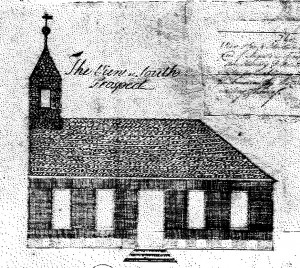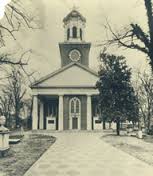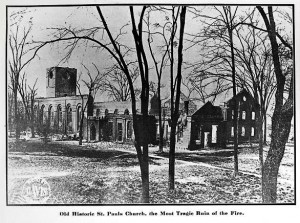History
The mother  church in Augusta, Saint Paul’s, began in 1749 when the gentlemen of the town erected a small, half-timbered chapel beside Fort Augusta, and appealed to the Society for the Propagation of the Gospel in Foreign Parts to send a minister. The Rev. Jonathan Copp arrived two years later and formal religious services have continued in Augusta since 1751. Georgia being a Royal colony, the official state religion was the Anglican Church, and Saint Paul’s was therefore a parish of the Church of England. The original building was severely damaged by refugees to Fort Augusta during the French and Indian War (1754-1763), and a second building was erected. It was destroyed in 1781 in the Second Siege of Augusta during the Revolutionary War, the British having turned the churchyard and cemetery into Fort Cornwallis as their defense against the patriot army.
church in Augusta, Saint Paul’s, began in 1749 when the gentlemen of the town erected a small, half-timbered chapel beside Fort Augusta, and appealed to the Society for the Propagation of the Gospel in Foreign Parts to send a minister. The Rev. Jonathan Copp arrived two years later and formal religious services have continued in Augusta since 1751. Georgia being a Royal colony, the official state religion was the Anglican Church, and Saint Paul’s was therefore a parish of the Church of England. The original building was severely damaged by refugees to Fort Augusta during the French and Indian War (1754-1763), and a second building was erected. It was destroyed in 1781 in the Second Siege of Augusta during the Revolutionary War, the British having turned the churchyard and cemetery into Fort Cornwallis as their defense against the patriot army.
After the war, former Anglicans reorganized an Episcopal congregation, and meetings were held at available public buildings beginning in 1785. In 1786 they called a rector, Adam Boyd, who was sent by the parish in 1788 to Connecticut to receive Holy Orders from Samuel Seabury, America’s first Episcopal Bishop. The Trustees of the Academy of Richmond County, who controlled the property, constructed a third building on the site, but Boyd was considered the regular minister and held Episcopal services there for several years.
Presbyterians gained control by 1804, when First Presbyterian Church was founded at Saint Paul’s. After the Presbyterians constructed their own building on Telfair Street in 1809-12, the Episcopalians formed a society in 1816, and were granted ownership of the colonial churchyard in 1818, when Saint Paul’s was incorporated by the State of Georgia. A fourth church was erected at that time, designed by John Lund, architect, and consecrated in 1821 by the Bishop of South Carolina. It was brick, laid in Flemish bond, with an impressive bell tower, almost identical to the present building.
In the ensuing years Saint Paul’s witnessed the growth of city, and increased in membership. The parish hosted the convention in 1823 when the Episcopal Diocese of Georgia was organized. A church school was added in 1843; an orphanage was established by the ladies of the church in the 1850s; and the building was converted into a hospital during the Civil War. The first and last General Councils of the Episcopal Church in the Confederate States of America were held at Saint Paul’s in 1862 and 1865, respectively. Confederate General Leonidas Polk, Bishop of Louisiana, was buried here after being killed near Atlanta in 1864, as they could not get his remains back to New Orleans. Saint Paul’s was expanded in the late 1860s, and the interior of the church was remodeled in the Gothic style in the late 1880s, following the Charleston earthquake of 1886, which damaged the interior. A new Parish Hall was built in 1912.
 The great Augusta fire of March 1916 destroyed over 30 blocks of the city, and perhaps the greatest loss was Saint Paul’s Church after the adjacent cotton warehouse exploded into the new parish hall, and soon engulfed the old church in flames. Services were held under a tent in the churchyard, and in the courthouse until the parish house could be replaced. The services of Augusta architect Henry Ten Eyck Wendell were secured to design the fifth building on the site. Although Wendell emulated the exterior of the 1820 church, he elongated the nave by pushing the altar further back, and he changed the windows from Gothic to Roman arches. The interior, however, was pure Georgian, borrowing heavily from designs of Sir Christopher Wren in London. Wendell died before the building was completed, but it is considered his masterpiece. The rebuilt parish house was finished in 1917, and the church in 1918, with consecration of the new building held in 1919. Memorial stained glass windows were added through the 1960s. The chapel and parish hall were remodeled in the 1970s, and the Children’s Ministries Center was completed in 2000. The River Room and Berlin Room were finished in 2008, and today serve many community events unrelated to the church.
The great Augusta fire of March 1916 destroyed over 30 blocks of the city, and perhaps the greatest loss was Saint Paul’s Church after the adjacent cotton warehouse exploded into the new parish hall, and soon engulfed the old church in flames. Services were held under a tent in the churchyard, and in the courthouse until the parish house could be replaced. The services of Augusta architect Henry Ten Eyck Wendell were secured to design the fifth building on the site. Although Wendell emulated the exterior of the 1820 church, he elongated the nave by pushing the altar further back, and he changed the windows from Gothic to Roman arches. The interior, however, was pure Georgian, borrowing heavily from designs of Sir Christopher Wren in London. Wendell died before the building was completed, but it is considered his masterpiece. The rebuilt parish house was finished in 1917, and the church in 1918, with consecration of the new building held in 1919. Memorial stained glass windows were added through the 1960s. The chapel and parish hall were remodeled in the 1970s, and the Children’s Ministries Center was completed in 2000. The River Room and Berlin Room were finished in 2008, and today serve many community events unrelated to the church.
Biographical Sketches of Post Revolutionary Augustans interred in Saint Paul’s Churchyard Found here: Download Respect this Stone by Cecelia Robertson
Additional Information is available in this Self-Guided Tour Brochure



